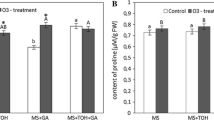Abstract
Callus and cell suspension cultures of cowpea (Vigna unguiculata) were induced with 2,4-dichlorophenoxyacetic acid and grown at different NaCl concentrations. The cell biomass yield and its total lipid content decreased with increasing salinity. However, while the hexose content in lipids was higher, the amount of lipid phosphorus was significantly lower in both agar and cell suspension cultures. Ion-transport rates with artificial membranes prepared with different lipid fractions showed that lipids from cells grown in a saline medium were less permeable to Na+ and to Cl- than those grown in a non-saline medium. Also the permeability of membranes prepared with glycolipids was lower than those prepared with phospholipids and whole lipids. Apparently, the increase of hexose/phosphorus ratio in membrane lipids is induced in response to the halo-adaptation process.
Similar content being viewed by others
References
Bartlett GR (1959) Phosphorus assay in column chromatography J. Biol. Chem. 234: 466–468
Brown DJ & Du Pont FM (1989) Lipid composition of plasma membranes and endomembranes prepared from roots of barley (Hordeum vulgare). Plant Physiol. 90: 955–961
Chandler SF & Thorpe TA (1986) Variation from plant tissue cultures: Biotechnological application to improving salinity tolerance. Biotechnol. Adv. 4: 117–135
Cheeseman JM (1988) Mechanisms of salinity tolerance in plants. Plant Physiol. 87: 547–550
Curatolo W (1987) Glycolipid function. Biochem. Biophys. Acta 906: 137–160
Dubois M, Gilles KA, Hamilton JK, Rebers PA & Smith F (1956) Colorimetric methods for determination of sugars and related substances. Anal. Chem. 28: 350–356
Greenway H & Munns R (1980) Mechanisms of salt tolerance in non-halophytes. Annu. Rev. Plant. Physiol. 31: 149–190
Hirayama O & Mihara M (1987) Characterization of membrane lipids of higher plants different in salt-tolerance. Agr. Biol. Chem. 51: 3215–3221
Hirayama O, Tanaka N & Kuromi Y (1987) The use of lipid-impregnated Millipore filters for examining the permeability properties of membrane lipids. Agr. Biol. Chem. 51: 1203–1205
Kates M (1972) Techniques of Lipidology; Isolation, Analysis and Identification of Lipids. North-Holland Publishing Company, Amsterdam
Kavi-Kishor PB (1988) Effects of salt stress on callus cultures of Oryza sativa L. J. Exp. Bot. 39: 235–240
Kavi-Kishor PB & Reddy GM (1985) Resistance of rice callus tissue to sodium chloride and polyethylene glycol. Current Sci. 54: 1129–1131
Kuiper PJC (1968a) Lipids in grape roots in relation to chloride transport. Plant Physiol. 43: 1367–1371
Kuiper PJC (1968b) Ion transport characteristics of grape root lipids in relation to chloride transport. Plant Physiol. 43: 1372–1374
Kuiper PJC (1969) Effect of lipids on chloride and sodium transport in beans and cotton plants. Plant Physiol. 44: 968–972
Kuiper PJC (1980) Lipid metabolism of higher plants in saline environments. Physiol. Vég. 18: 83–88
Kuiper D & Kuiper PJC (1978) Lipid composition of the root of Plantgo species: response to alteration of the level of mineral nutrition and ecological significance. Physiol. Plant. 44: 81–86
Müller M & Santarius KA (1978) Changes in chloroplast membrane lipids during adaptation of barley to extreme salinity. Plant Physiol. 62: 326–329
Murashige T & Skoog F (1962) A revised medium for rapid growth and bioassays with tobacco tissue cultures. Physiol. Plant. 15: 473–497
Nabors MW, Daniels A, Nadolny L & Brown C (1975) Sodium chloride tolerant lines of tobacco cells. Plant Sci. Lett. 4: 155–159
Nabors MW, Gibbs SE, Bernstein CS & Meis ME (1980) NaCl-tolerant tobacco plants from cultured cells. Z. Pflanzenphysiol. 97: 13–17
Paek KY, Chandler SF & Thorpe TA (1988) Physiological effects of Na2So4 and NaCl on callus cultures of Brassica campestris (Chinese cabbage). Physiol. Plant. 72: 160–166
Pandey R & Ganapathy PS (1985) The proline enigma: NaCl-tolerant and NaCl-sensible callus lines of Cicer arietinum. Plant. Sci. 40: 13–17
Stavarek SJ & Rains DW (1984) The development of tolerance to mineral stress. Hort. Science 19: 377–382
Stuiver CEE, Kuiper PJC & Marschner H (1978) Lipid from bean, barley and sugar beet in relation to chloride transport. Plant Physiol. 43: 1372–1374
Stuiver CEE, Kuiper PJC, Marschner H & Kylin A (1981) Effects of salinity and replacement of K+ by Na+ on lipid composition in two sugar beet inbred lines. Physiol. Plant. 52: 77–82
Vazquez-Duhalt R & Greppin H (1987) Growth and production of cell constituents in batch cultures of Botryococcus sudeticus. Phytochemistry 26: 885–889
Widholm JM (1972) The use of fluorescein diacetate and phenosafranina for determining viability of cultured plant cells. Stain. Technol. 47: 189–194
Author information
Authors and Affiliations
Rights and permissions
About this article
Cite this article
Vazquez-Duhalt, R., Alcaraz-Meléndez, L. & Greppin, H. Variation in polar-group content in lipids of cowpea (Vigna unguiculata) Cell cultures as a mechanism of haloadaptation. Plant Cell Tiss Organ Cult 26, 83–88 (1991). https://doi.org/10.1007/BF00036110
Received:
Accepted:
Issue Date:
DOI: https://doi.org/10.1007/BF00036110



